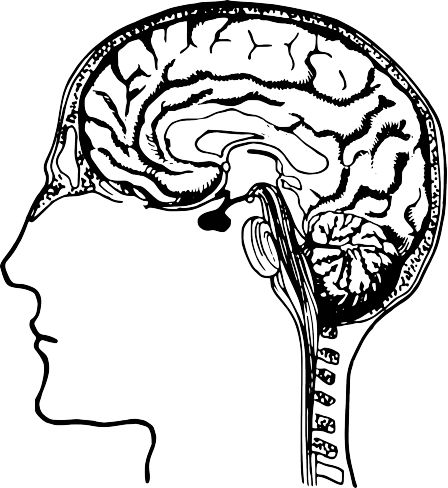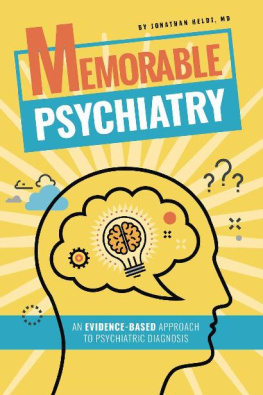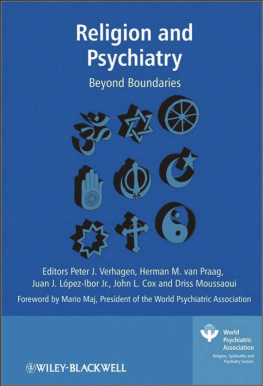Memorable
Psychiatry
Jonathan Heldt, M.D.
Also available from the same author:
Memorable Psychopharmacology
Memorable Neurology
The content of this book is not intended to be a replacement for proper medical training, nor is it intended to substitute for professional medical advice, diagnosis, or treatment. Always seek the advice of your physician or other qualified health provider with any questions you may have regarding a medical condition.
Editing and behavioral consultation provided by Juliane Heldt, BCBA (Board Certified Behavior Analyst) .
Copyright 2018 Jonathan Heldt.
All rights reserved.
Revision 1.3. Last revised October 22, 2019.
ISBN: 1543093205
ISBN-13: 978-1543093209
DEDICATION
To my grandparents Steve and Young-cha Pai who crossed more oceans, worked longer hours, and endured greater hardships than anyone should have to so they could provide for their family. Thank you for giving us the life we have today.
CONTENTS
Acknowledgments | i |
| Introduction | |
| Diagnosis | |
| Evaluation | |
| Psychiatric Emergencies | |
| Depression | |
| Mania | |
| Psychosis | |
| Addiction | |
| Anxiety | |
| Obsessions and Compulsions | |
| Trauma | |
| Personality | |
|  Borderline Borderline
| |
| Dissociation | |
| Somatization | |
| Eating Disorders | |
| Development | |
| Autism | |
| Inattention and Hyperactivity | |
| Externalization | |
| Psychopathy | |
| Dementia | |
| Sleep | |
| Final Review | |
ACKNOWLEDGMENTs
A world of thanks to Juliane Heldt, BCBA (Board Certified Behavior Analyst) for putting my books into the hands of so many people who would not otherwise have seen them. Thank you for being the best editor, publicist, supporter,
interdisciplinary consultant, and sister I could ask for.
1 INTRODUCTION
 Welcome to the most fascinating field in medicine. Psychiatry deals with the most complex organ in the human bodythe brain and the way in which it interfaces not only with the other parts of the body but also with other people and society as a whole. More than any other discipline of medicine, psychiatry requires a meaningful understanding of the world and its complexities. However, too often psychiatry is experienced not as fascinating but as bewildering, mystifying, or illogical. The central tension of psychiatryhow little we know about the brain and its inner workingsis viewed not as a target for curiosity but instead as a barrier to entry. Attempts to make sense of the minds workings (such as the algorithmic diagnoses that form the basis for most textbooks on psychiatry) often risk going too far in the opposite direction, trading in the dynamic intricacies of the human mind for a simplified cookbook of what can go wrong with the brain. This makes psychiatry less bewildering, but it also risks turning it into something boring, tedious, and rote.
Welcome to the most fascinating field in medicine. Psychiatry deals with the most complex organ in the human bodythe brain and the way in which it interfaces not only with the other parts of the body but also with other people and society as a whole. More than any other discipline of medicine, psychiatry requires a meaningful understanding of the world and its complexities. However, too often psychiatry is experienced not as fascinating but as bewildering, mystifying, or illogical. The central tension of psychiatryhow little we know about the brain and its inner workingsis viewed not as a target for curiosity but instead as a barrier to entry. Attempts to make sense of the minds workings (such as the algorithmic diagnoses that form the basis for most textbooks on psychiatry) often risk going too far in the opposite direction, trading in the dynamic intricacies of the human mind for a simplified cookbook of what can go wrong with the brain. This makes psychiatry less bewildering, but it also risks turning it into something boring, tedious, and rote.
There is a middle ground. This book aims to make the disorders we treat understandable through the use of clear explanations, analogies, and mnemonics. A good understanding of these disorders is essential for allowing clarity in diagnosis and avoiding the pitfalls of overdiagnosis, including use of ineffective or even harmful treatments. In addition, this book also aims to provide practical clinical tools that you can use when working with patients in the real world.
By design, some of the mnemonics and analogies included may be silly, shocking, or amusing. This is done in service of making the information more accessible, as provoking an emotional response is one of the best ways of getting information to stick. Nothing in this book is intended to stigmatize, trivialize, or humiliate anyone struggling with any of the disorders mentioned.
Well begin our study of mental disorders with an overview of the line between normalcy and illness. From there, we will learn how to perform a clinical evaluation of someone with a psychiatric problem as well as how to respond to psychiatric emergencies. After that, the diagnostic portion of the book begins in earnest as we begin to learn about the major syndromes in psychiatry, including depression, mania, psychosis, anxiety, addiction, personality disorders, and more.
Through each chapter, we will not only learn about each disorder in isolation but also discover out how to differentiate between different psychiatric disorders, many of which have similar or overlapping symptoms. Unfortunately, this means that the going will be a little rough at the beginning, as there is no way to compare diagnoses across categories without bringing up disorders that we have not covered yet. However, rest assured that it will get easier as time goes on ! In addition, dont be afraid to skip ahead if you need more background information on any given subject. Frequent references between chapters will also be made to facilitate understanding. A general understanding of physiology (including the autonomic nervous system) and pathology will be helpful for understanding all of the concepts, but it is not required.
Concepts in boxes are particularly high-yield ! An easy way to remember them will be in italics below. |
Now, lets begin
2 DIAGNOSIS
 In medicine, diagnosis is the process of determining what condition best explains someones illness. Accurate diagnosis is the basis on which clinicians make decisions about how best to relieve suffering, and without a diagnosis, appropriate treatment remains out of reach. Diagnosis is accomplished through a careful evaluation of a patients signs ( objective findings that you can observe directly, such as redness of the eyes) and symptoms ( subjective concerns that the patient tells you about, such as a headache). Signs and symptoms in psychiatry are collectively referred to as phenomenology .
In medicine, diagnosis is the process of determining what condition best explains someones illness. Accurate diagnosis is the basis on which clinicians make decisions about how best to relieve suffering, and without a diagnosis, appropriate treatment remains out of reach. Diagnosis is accomplished through a careful evaluation of a patients signs ( objective findings that you can observe directly, such as redness of the eyes) and symptoms ( subjective concerns that the patient tells you about, such as a headache). Signs and symptoms in psychiatry are collectively referred to as phenomenology .
Within psychiatry, many of the conditions we treat are syndromes rather than specific disease processes. A syndrome is a set of signs and symptoms that tend to occur together. For example, when someone says that they have a cold, they are saying that they have a set of signs and symptoms (such as cough, runny nose, sore throat, fatigue, muscle aches, and loss of appetite) that tend to signify something when they cluster together.
Diagnosing a syndrome is not the same as identifying the underlying cause (just saying you have a cold is not the same as identifying a rhinoviral infection). However, even if it doesnt identify the exact cause of the problem, diagnosing a syndrome is still helpful because it suggests a certain prognosis and treatment response . For example, identifying that someone has a cold suggests that the signs and symptoms will probably go away on their own in a few days or weeks (its prognosis) and that antibiotics are unlikely to help (its treatment response).
Next page












 Borderline
Borderline Welcome to the most fascinating field in medicine. Psychiatry deals with the most complex organ in the human bodythe brain and the way in which it interfaces not only with the other parts of the body but also with other people and society as a whole. More than any other discipline of medicine, psychiatry requires a meaningful understanding of the world and its complexities. However, too often psychiatry is experienced not as fascinating but as bewildering, mystifying, or illogical. The central tension of psychiatryhow little we know about the brain and its inner workingsis viewed not as a target for curiosity but instead as a barrier to entry. Attempts to make sense of the minds workings (such as the algorithmic diagnoses that form the basis for most textbooks on psychiatry) often risk going too far in the opposite direction, trading in the dynamic intricacies of the human mind for a simplified cookbook of what can go wrong with the brain. This makes psychiatry less bewildering, but it also risks turning it into something boring, tedious, and rote.
Welcome to the most fascinating field in medicine. Psychiatry deals with the most complex organ in the human bodythe brain and the way in which it interfaces not only with the other parts of the body but also with other people and society as a whole. More than any other discipline of medicine, psychiatry requires a meaningful understanding of the world and its complexities. However, too often psychiatry is experienced not as fascinating but as bewildering, mystifying, or illogical. The central tension of psychiatryhow little we know about the brain and its inner workingsis viewed not as a target for curiosity but instead as a barrier to entry. Attempts to make sense of the minds workings (such as the algorithmic diagnoses that form the basis for most textbooks on psychiatry) often risk going too far in the opposite direction, trading in the dynamic intricacies of the human mind for a simplified cookbook of what can go wrong with the brain. This makes psychiatry less bewildering, but it also risks turning it into something boring, tedious, and rote. In medicine, diagnosis is the process of determining what condition best explains someones illness. Accurate diagnosis is the basis on which clinicians make decisions about how best to relieve suffering, and without a diagnosis, appropriate treatment remains out of reach. Diagnosis is accomplished through a careful evaluation of a patients signs ( objective findings that you can observe directly, such as redness of the eyes) and symptoms ( subjective concerns that the patient tells you about, such as a headache). Signs and symptoms in psychiatry are collectively referred to as phenomenology .
In medicine, diagnosis is the process of determining what condition best explains someones illness. Accurate diagnosis is the basis on which clinicians make decisions about how best to relieve suffering, and without a diagnosis, appropriate treatment remains out of reach. Diagnosis is accomplished through a careful evaluation of a patients signs ( objective findings that you can observe directly, such as redness of the eyes) and symptoms ( subjective concerns that the patient tells you about, such as a headache). Signs and symptoms in psychiatry are collectively referred to as phenomenology .